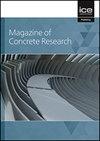海藻酸钠改性微生物修补材料对砂浆裂缝修补的影响
IF 1.6
4区 工程技术
Q3 CONSTRUCTION & BUILDING TECHNOLOGY
引用次数: 0
摘要
针对传统混凝土裂缝修补材料的不足,开发了新一代的修补材料——基于海藻酸钠改性的微生物修补材料。该方法采用刷刷技术,将微生物固定在待修复的裂缝上,使其能原位沉积碳酸钙修复裂缝。本文对修补材料的基本性能进行了研究,对修补砂浆裂缝前后试件的宏观形貌和表面吸水率进行了研究,并对修补产品的材料变化和微观结构进行了分析。结果表明:(1)经海藻酸钠改性的微生物修复材料的CaCO3含量、吸水率和热收缩率均优于未加微生物处理的修复材料;(2)采用以海藻酸钠为载体的涂刷技术将微生物固定在砂浆表面的裂缝中,仅经过两次修补就能紧紧附着在裂缝上,产生以海藻酸钙和碳酸钙为主的修补产品,表面吸水率较修补前降低约65%。本文章由计算机程序翻译,如有差异,请以英文原文为准。
Effect of microbial repair materials based on sodium alginate modification on mortar crack repair
In response to the shortcomings of traditional concrete crack repair materials, a new generation of repair materials has been developed - a microbial repair material based on sodium alginate modification. The method adopts a brushing technique to fix the microorganisms on the cracks to be repaired so that they can deposit calcium carbonate in situ to repair the cracks. This paper carried out a study of the fundamental properties of the repair material, as well as studied the macroscopic morphology and surface water absorption of its specimens before and after repairing mortar cracks, and analyzed the material changes and microstructures of the repair products. The results showed that: (1) the CaCO3 content, water absorption ratio and heating shrinkage rate of the microbial repair material modified with sodium alginate were better than those of the repair material without microorganisms; (2) the microorganisms were fixed in the cracks on the surface of the mortar using the brushing technique with sodium alginate as the carrier and were able to adhere tightly to the cracks after only two repairs to produce repair products, which were mainly calcium alginate and calcium carbonate, and the surface water absorption rate was reduced by about 65% compared to that before the repair.
求助全文
通过发布文献求助,成功后即可免费获取论文全文。
去求助
来源期刊

Magazine of Concrete Research
工程技术-材料科学:综合
CiteScore
4.60
自引率
11.10%
发文量
102
审稿时长
5 months
期刊介绍:
For concrete and other cementitious derivatives to be developed further, we need to understand the use of alternative hydraulically active materials used in combination with plain Portland Cement, sustainability and durability issues. Both fundamental and best practice issues need to be addressed.
Magazine of Concrete Research covers every aspect of concrete manufacture and behaviour from performance and evaluation of constituent materials to mix design, testing, durability, structural analysis and composite construction.
 求助内容:
求助内容: 应助结果提醒方式:
应助结果提醒方式:


